Leave the leaves – the new, easy way to deal with autumn gardens
Leave the leaves is the new gardening mantra.
It immediately appeals to me more than getting out a leaf blower or rake, bagging up leaves and finding somewhere to store them while they break down into leaf mould. (Never mind actually putting them in a car and taking them to the local dump!)
Raking leaves was the most boring task of my childhood. My mother ushered us all out for hours of back-breaking tedium.
Yet today’s ‘leave the leaves’ campaign on social media suggests that much of this work was unnecessary. Others suggest, however, that leaving the leaves could damage your garden or even your health.
Having left leaves on my own borders for 15+ years with no ill-effects, I’ve done some more research to see where we can leave the leaves and where they would be better swept up.
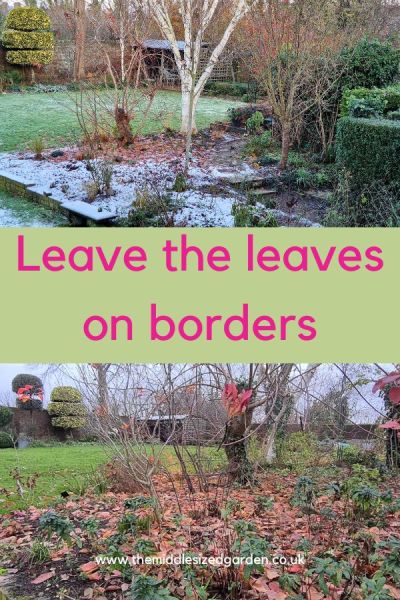
This is my central border. I have never cleared any leaves away. Most of them rot down by the spring, although a few are blown onto the lawn on dry, windy days.
Can you leave the leaves on borders?
You can leave leaves on most borders without any problem. They will break down over the winter and by spring, you’ll hardly notice them.
As they break down, they’ll return nutrition to the soil.
Piles of leaves also offer habitats to wildlife. People have pointed out – correctly – that this includes slugs and snails. But it also includes slug and snail predators, such as hedgehogs, frogs, toads, slow-worms and ground beetles.
There are only two potential problems with leaving leaves on borders.
Firstly, some trees have very thick, big leaves that take a long time to break down. The leaves from my Magnolia grandiflora can cover smaller plants, such as Saxifrage ‘London Pride’. This would deprive them of light, so I do push them off (when I notice).
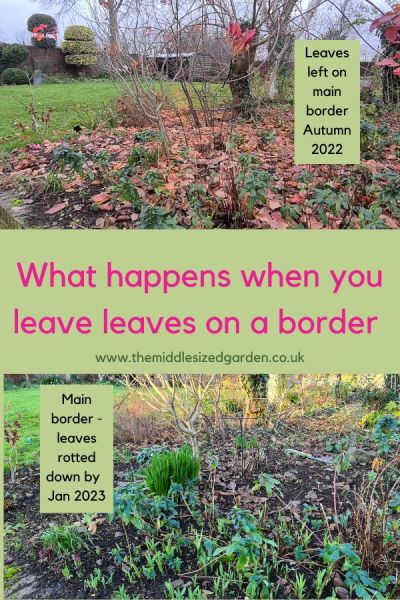
The top photo is my central border in autumn 2022. The picture below it shows that the leaves have decomposed around 3 months later. I did see a few traces of leaf when I went really close up, but it wasn’t a problem.
Do leaves blow around the garden if you leave them?
Many people see leaves blowing around a city street. They assume that leaves on borders will blow around the garden in the same way. But, mostly, they don’t.
I have tested this in my own garden over many winters. (When I find leaves on the lawn, I can tell where they’ve come from according to what type they are!)
I have never known leaves blow off borders if the leaves are at the back, right next to a wall or fence. The wind can’t get behind them to blow them around. I have even left quite a high pile of leaves at the back of a border and it has stayed there, gradually breaking down.
However, if your border is in the middle of the garden, it’s much easier for leaves to blow around the rest of the garden. If you have a wet autumn, they’ll mostly stay where they fall, but in dry, sunny weather you will get some leaves blowing around the lawn, paths or terraces. Not all the leaves will blow around, but some will.
Can leaves be used as mulch?
Yes, leaves make an excellent mulch.
There are two schools of thought. There are those who leave the leaves in borders or even sweep leaves from the lawn directly into borders.
And there are those who advise chopping the leaves up first.
Either is fine (except for those big thick leaves, which do need chopping up). The chopped-up leaves will decompose more quickly and are less likely to blow around.
Can leaves be added to the garden compost bin?
Yes. I’ve often added leaves to the garden compost bin. They don’t decompose as quickly as many garden clippings or raw fruit and veg, but that doesn’t have to matter.
Unless you’re sieving your garden compost to plant seeds, then having some partially composted element isn’t a problem. You can spread compost on the garden even if it’s not completely broken down.
However, one effective way of adding leaves to the compost is to mow the leaves on the lawn. Then throw the mixed bag of lawn clippings and chopped up leaves into the compost bin. It’s a perfect mix and will break down quickly.
Here’s a really easy guide to making your own garden compost.
You can also bag up leaves separately to make leaf mould. This is a wonderfully nutritious mulch for your garden borders, but I have found that leaves seem to decompose much more slowly when they’re all bagged up together.
If you are going to bag up leaves, make sure they’re moist and tear air holes in the bags. They will take at least 1-2 years to break down.
Can you leave leaves on lawns?
This question causes a lot of arguments. Having looked at many of them, I can summarise it.
If you have lots of leaves, which lie in a thick layer on your lawn, then it will take them months to break down. In that time, your lawn will be deprived of sunlight. This may cause bare patches, especially if you have lots of the thicker, more leathery leaves.
However, if you only have a scattering of leaves over your lawn, then they will break down naturally, adding nutrition to the lawn.
The easiest way to deal with leaves on the lawn is to run a mower over them. Use a higher setting than you would in summer when the grass is growing strongly.
You can either throw the leaves and lawn clippings into the compost bin, throw it into the borders as a mulch or leave the chopped up leaves where they are on the lawn. They’ll break up more quickly than whole leaves will.
In the United States, where many of the lawn grasses aren’t native, this debate often veers off into the ‘lawns are bad’ argument.
It’s important to remember that there’s a difference between maintaining a non-native lawn in an area that isn’t suitable for lawns and having a mainly native lawn in the UK, where lawns use up relatively few resources and are both sustainable and wildlife-friendly.
You can find out more about an easy-care sustainable lawn here.
Will the leaves cause bad moulds when they rot down?
Nature does not rake up leaves. It allows them to rot down, returning their nutrition to the soil.
Leaves rot down on a forest floor all year round. Forests and woods don’t smell bad. And people aren’t usually warned against walking in them because of ‘bad moulds.’
But if you search whether leaves cause bad moulds (molds) online, you will find hundreds of warnings, almost all from the United States, on the dangers.
Certainly moulds, funghi and fallen leaves are a factor in the autumn. These can trigger allergies, similar to those from pollen in summer. A few of these allergies and reactions can be severe.
But I find it odd that people are much more concerned about this in the United States than they are in the UK.
Are our fallen leaves less likely to cause allergies? Or do some countries worry more about leaves than others?
This may also be a volume issue. If you’ve got one or two trees of different kinds in your garden, then you won’t have a huge number of leaves at any one time. But if your property is surrounded by hundreds of the same deciduous trees all losing their leaves at once, then leaves will take longer to break down. The funghi that help break them down may be around longer.
It may also be worth noting that nature doesn’t sweep leaves into a big pile, so perhaps the balance of funghi and moulds may be different if leaves are in piles rather than simply left.
And not all ‘moulds’ are bad…
You’re certainly more likely to see funghi in autumn, when leaves are falling, but this doesn’t mean that leaving leaves causes them all. Or that they’re necessarily bad.
The Royal Horticultural Society says that most types of funghi are very good for gardens, helping plants to take up nutrients and dead matter to decompose.
Their latest Wildlife garden at RHS Wisley has areas where funghi have deliberately been planted.
There’s more from the RHS about adopting a more relaxed attitude to gardening in gardening for biodiversity.
There are a few damaging funghi, such as honey fungus and verticilium wilt. But sweeping up your leaves isn’t likely to make a lot of difference to them, one way or the other.
But, as with everything, I think it’s worth taking an individual approach to this. Is there any scientific research done in your area? Have you – or your family – personally experienced problems with leaves in the autumn? What’s right for one person isn’t necessarily right for another, and if you do get health issues in autumn, it’s important to address them.
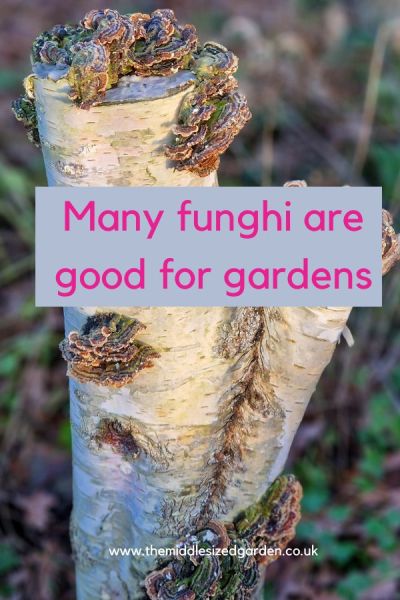
These funghi were deliberately introduced into the Wildlife Garden at RHS Wisley.
Are fallen leaves poisonous to dogs (or other pets)?
As I said in How to Puppy-Proof Your Garden, about 25% of any garden is likely to be toxic to both humans and pets. But most humans and pets don’t eat the plants.
Plant poisoning is relatively rare, but it is vital to keep a close eye on puppies, kittens and toddlers in a garden as a general safety measure. You never know what they’re going to put in their mouths or what other harm they could do to themselves.
The PDSA in the US (People’s Dispensary For Sick Animals) says that dead leaves are less likely to cause problems that green leaves.
There are a few plants which are very toxic, such as oleander or ricinus. I personally don’t grow either for that reason. But you will see oleander all over Europe, with lots of cats and dogs sunning themselves in front of the bushes.
I’d suggest asking your local vet if there are plants in your area that seem to cause problems with dogs or cats eating the leaves.
If you get a vague, general answer, that probably means the vet can’t remember specific cases (so there probably are few or none). If your vet has dealt with poisonings due to pets eating fallen leaves or specific plants, they’ll say so pretty clearly.
Can you leave leaves on paths?
Don’t leave the leaves on paths or places where you walk. It makes them slippy in rainy or icy weather.
But you don’t need to take the leaves very far. I just scoop mine up with leaf scoopers (I currently use these Straeme leaf grabbers) and deposit them in the nearest border (at the back, by the wall!)
Note that links to Amazon are affiliate, see disclosure.
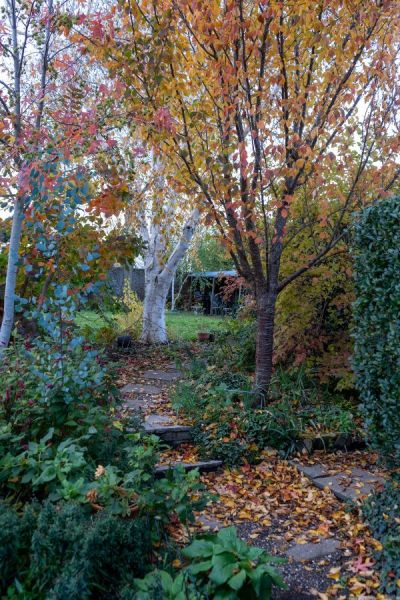
Paths and terraces can be slippy if they are covered in wet or frozen leaves. A friend of mine says she has also slipped while walking on her lawn, so that is another factor to take into account.
Can leaves grow roots?
Leaves can’t regenerate or grow roots. You won’t find lots of tree seedlings popping up because you leave leaves on your borders or lawn.
Any other problems?
There is a wonderful Instagrammer Alexis Nicole who says in her video: ‘leave the leaves. They won’t break into your house and steal all your wine.’
How refreshing to find something we can all agree on. I think we can safely say that is true for wherever you live.
The ‘leave the leaves’ campaign is all part of gardening to support wildlife. It also saves time, effort (and even a little money) for the gardener, so this one is a ‘win/win!’
But, as with everything, there’s no ‘one size fits all’ advice in gardening. If you’re reluctant that this will work for you, perhaps try leaving leaves on one border and see what happens.
Let me know how you find it.
Pin to remember leave the leaves
And do join us. See here for a free weekly email with more tips, ideas and inspiration.
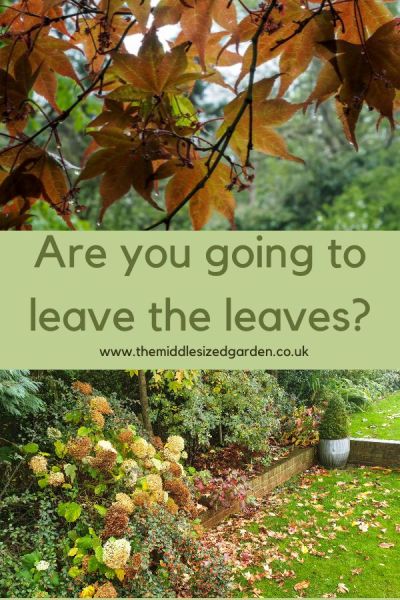
























“Embracing ‘Leave the Leaves’ is not just a trend; it’s a sustainable approach to autumn gardening that benefits both your yard and the environment. By letting fallen leaves decompose naturally, you nourish the soil, support local wildlife, and reduce the need for synthetic fertilizers. Plus, it’s incredibly easy – a win-win for busy gardeners and Mother Nature alike!”
It is, I agree!
Thanks for a timely post! I have a small garden in south west UK, rather wet, plenty of leaves from both ours and neighbouring trees. As usual as soon as I start any tidying I find catapillars and other wildlife that I want to keep, so I only cleared the lawn and left most of the leaves in the borders, so I was very pleased to read your findings about it here. I recently heard radio 4 GQT talking about the need to protect the soil over winter with a mulch or similar, and I guess fallen leaves will do that job. I don’t know if they cause rot in some plants (ours is a very wet enclosed garden) but I’ll take the risk and see what happens in the spring!
I think they can cause rot if they’re large leaves and small plants, but I generally find that most of my plants survive. But that’s roughly what you’d expect if you did remove the leaves – some plants like the extra protection and would prefer their cosy leaf ‘blanket’ and others need a bit more air. So we can win either way, if we accept losing a few, hope it works for you.
For the last few years, I’ve left the leaves on my lawn and borders. I’ve had no (edible) apples on my apple tree for the last two years due to codling moth. I read that the caterpillars overwinter on rotting leaves under apple trees. Do you know if this is true? This year I’m raking up the leaves under my apple tree just in case!
I’ve had a look at this online and can’t find any trace of a recommendation to clear up leaves under an apple tree for this reason amongst the bigger sites. The RHS and Wikipedia both have quite a bit about the codling moth, and recommend pheromone traps in May. However, no-one specifically says that codling moth cocoons DONT overwinter in piles of leaves either. Nor is there any guidance as to how far away you might have to take the leaves so that the moth don’t just emerge in spring and fly back to the trees or how to dispose of them otherwise(burning could kill beneficial life, too). I’m sure some sites do recommend it though, and if piles of leaves create habitats for wildlife, then presumably the codling moth cocoon is part of that. Sorry to be inconclusive over this, but I’d suggest giving the leaves a good rake over at least, so as to expose any cocoons, and then going for the pheromone traps in May.
Thank you very much. I’ll investigate traps
I leave them on the beds, but usually blow the pathways clear. So 50/50 I guess, it’s just more manageable and a bit tidier.
I agree
I have a large garden with a few horse chestnut trees. I’ve heard that their leaves are not good for compost and shouldn’t be used for composting later on a vegetable garden. Is that true ?
This is one of those US vs UK issues – I see quite a lot of sites in the US recommending you don’t compost horse chestnut leaves, but the RHS in Britain list them as leaves you can compost, but best chopped up because they’re thicker and don’t break down as fast. There are sites that say that horse chestnut leaves have toxins that may affect vegetables if they are grown in soil where horse chestnut leaves are in the compost, but I can’t see any actual research confirming or measuring the actual effects of this.There’s a difference between a plant containing a toxin and whether that toxin has any practical effect, particularly once it’s broken down. So it’s up to you to decide – you could research ‘horse chestnut leaves toxins’ etc on Google and go deeper, if you want to be sure. I suspect that there are many vegetables grown near to horse chestnut trees where people aren’t aware of the issue.
I’m in western North Carolina mountains. Lots of gorgeous leaves and I keep ‘em all but do rake, blow, and drag them to various places, depending if they are oak or maple or poplar or dogwwod or redbud. This year I am widening some borders by putting piles 3feet deep atop cardboard to kill the grass underneath. Oak leaves go to the blueberries and azaleas and hydrangeas. We have lots of trees, being in the mountains. Yes, I do get a sniffly nose, but the air feels great and I’m 72 so the molds are evidently not killers.
Great idea to put the leaves in the most appropriate places!
We have 5 acres, 4 of them woods, near Asheville ,North Carolina, and I treasure every leaf one way or another. This year a particularly gorgeous carpet but yes they are backbreaking. We blow and rake and drag (tarps) the leaves near house. Oaks go to blueberries and azaleas, maples go atop cardboard where i am killing grass to widen borders. Afterwards, I go swimming to unkink. I am 72. Love your blog.
Wonderful, what a glorious number of trees and thank you.
I live in Indiana where we have lots of leaves and lots of mold, but I’ve never seen moldy leaves. People here don’t tend to complain about allergies in the fall. Here’s the advice from Purdue, our ag university: https://turf.purdue.edu/what-to-do-with-all-those-falling-leaves/#:~:text=Research%20results%20at%20Purdue,not%20increase%20thatch%20or%20disease.
Thank you – glad to know that Purdue agrees with us leaf-shredders (as opposed to leaf blowers).
I’m happy to leave most leaves around the plants but not on them. We have so many lovely foliage plants still going strong and even still trying to flower I hate to see them marred by soggy old rotting leaves clinging to them.
Yes, I think that’s a good point.
We got rid of a lot of poor quality lawn and replaced it with a gravel garden. We usually get rid of leaves that lay thick on the gravel because we don’t want them rotting down on the gravel in case the weeds find it easier to root.
That does sound sensible, although not alot of fun! Getting leaves off gravel must be a bit of a challenge, but I completely agree with your reasoning.
In USA – well Connecticut at least – people sweep all their leaves up and leave them in piles on the edge of the pavement. The council then comes round and collects them all. We saw this in action only a couple or so weeks ago. Everywhere we went, there were large (and I mean large) piles of leaves on the edges of pavements, spilling onto roads. They do have a lot of trees in Connecticut, so I guess it makes sense for the council to take the the leaves and make compost which they can then sell back to the inhabitants.
I agree this is a good option if it’s being composted although I understand that in some places, it goes into landfill, which is a real waste. I wondered whether the habit of creating piles of leaves in this way contributed to the issue over leaf moulds and allergies, and whether it was one reason why the US seems more concerned about leaves and allergies than we are. But, on the other hand, they’re presumably not being left for very long. As you say, they do have a lot of trees, so their solutions are likely to be different from ours. Thank you for commenting.
This is a very useful article. My garden has many more evergreen trees than deciduous ones, but many leaves blow in from neighboring gardens. I like to collect the leaves for leaf mold. But this year I will leave the ones that land in my borders.
Thank you
This year I decided to use leaves to my advantage by putting them in front of my Stonewall to create a pathway and planting area for the following year. I tried it out in another location last winter and it worked at suppressing really vigorously growing golden rod. So this year I’ve decided to do it in front of the Stonewall and I’ve been gathering leaves from everywhere that I can
and putting them in front of the Stonewall and around Plantings to suppress grass and eliminate colonies of Goldenrod in places I don’t want them. It does seem to be working, it’s an excellent way to build pathways through a wild area. You just weed whack it down the grass and lay down your thick mat of leaves let it die down over the winter and the following spring you can either lay stone or just put in regular mulch and it will be great You can also plant into it and because the plant is above the leaves it has a head start. You can leave the leaves under crushed stones as well and it will suppress seeds blowing into plantings. It makes a great of food but it also because it takes the time to break down is great at killing off areas so if you want to eliminate things putting down a pile of leaves on top of it is a great way of doing it. And it’s free.
Interesting approach, thank you.